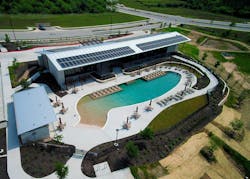Geothermal Contributes to Net-Zero Success
Austin, Texas
DESIGN TEAM:
Pacesetter Homes
One of the challenges, explains Douglas Gilliland, managing director of developer Taurus Investment Holdings, was to convince home builders to do things a bit differently. “Builders have established construction practices. They’re used to doing things a certain way because it has always worked for them.”
Whisper Valley incorporates a new business model in home building that consumers are demanding: net-zero energy capable homes selling at prices most consumers can afford—all in a planned community that itself is “sustainable.”
INFLUENCE:EcoSmart Solution a subsidiary of Taurus Investment Holdings, brought together the technologies needed to make a zero-energy capable community of this size possible with affordable prices. The EcoSmart program combines an innovative GeoGrid, solar PV, high-efficiency Bosch appliances and Google Nest products to make the vision for communities like Whisper Valley a reality.
All builders in Whisper Valley are required to hook up to EcoSmart’s GeoGrid, a 5-mile loop of underground distribution piping that links each home to a geo-exchange network, engineered and manufactured by REHAU, a global provider of hydronic technologies and a strategic partner in the Whisper Valley project. “It took a bit of time to figure out who was doing what,” says Dennis Ciani, head of marketing for Pacesetter Homes, an Austin-area builder that constructs about 500 homes per year, including most of the new homes in Whisper Valley. “But the geothermal loop was already in the ground and all homeowners had to do was tie into it, which turned out to be fairly easy to do.”
Builders were also required to adjust their floor plans to accommodate a geothermal heat pump to be located in each home’s insulated attic for maximum efficiency. As it turns out, Ciani says, “We didn’t have to alter our floor plans very much.” And when consumers learned that their heating and cooling capacity came mostly from the earth—and that the cost of the system was already embedded in the home price—“it became a major selling point.”
“Another selling point was reduced monthly costs of living through dramatically lower energy bills,” Ciani continued. “The sustainable technologies—the geothermal system, solar photovoltaic panels on the roofs and computerized controls in each Whisper Valley home—probably adds $15,000 or more to the price compared to similar conventional homes in nearby rural communities east of Austin,” he says. But when people consider the price of the home, they don’t always consider its monthly costs.
In central Texas, where temperatures average above 90°F during the summer months and can dip below freezing during the winter, utility bills are an enormous monthly cost. Whisper Valley’s integrated geothermal and solar systems bring those costs down to next to nothing—a reduction of $150 to $300 per month in the overall monthly cost for homeowners.
Whisper Valley residents also benefit from federal tax credits for both the solar PV system and the geothermal equipment included in their homes. Residents can expect a $7,000 to $10,000 tax credit, providing additional savings on their zero-energy capable homes.
